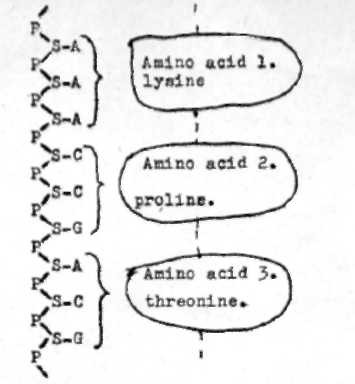Many of the Sareoso diagrams involve the numbers 21 and 64 and this article examines the way that these numbers crop up in genetic coding (the way that DNA encodes different amino acids). The article has been summarised from a Saros Research Paper How An Ancient Chinese Dragon Was Found Lurking Within A Modern Biochemical Chimera.
What is DNA?
DNA is life’s recipe book. A strand of DNA contains instructions on how to make proteins which in turn go to make up the body of a cell, a plant, an animal or a human being. Mechanisms within our cells read the DNA and make the protein. The instructions are simple in principle.
A DNA strand is like a ladder. Each side of the ladder is made from alternating phosphate (P) and sugar (S) molecules. The rungs of the ladder are attached to the sugar molecules, and each one consists of a pair of so-called ‘base’ molecules called adenine (A), cytosine (C), thymine (T) or guanine (G).
P P
\ /
S – A — T – S
/ \
P P
\ /
S – A — T – S
/ \
P P
\ /
S – C — G – S
/ \
P P
\ /
S – G — C – S
/ \
P P
\ /
S – A — T – S
/ \
P P
\ /
Adenine bonds only with thymine, and cytosine bonds only with guanine, so the possible rungs are AT, TA, GC, CG. Normally, the DNA is curled up in a spiral, but when a protein needs to be made, the DNA is unfurled.

What is a Protein?
A protein is made up of a sequence of simple molecules called amino acids. The DNA carries the code for the correct sequence of amino acids. The sequence of DNA bases down the ladder are divided into groups of three. Each group combination signifies a particular amino acid. For example, three adenine bases in a row (AAA) is a code for making the amino acid lysine.
The DNA is unfurled and split into two strands, and a copy of a section is made and sent to machines in the cell which makes proteins. These machine read the strand and string amino acids together in the right sequence to make a protein:

Example of amino acids being linked in accordance
with the sequence coded on a DNA strand.
As well as coding for amino acids, we also need a code for a ‘full stop’, telling the protein machine to stop making the protein and start another.
Here’s a more detailed explanation:
How Many Possibilities?
So how many possibilities are there for the DNA codes? A code consists of 3 letters, each of which is either C, A, T, or G. There are four possibilities for the first letter, and for each of these there is four possibilities for the second one (4×4=16) and for each of these there is four possibilities for the third letter, giving a total of 4x4x4 = 64.
In fact there are only 20 different amino acids, and with the ‘full stop’, we have a total of 21 possibilities that the DNA code must represent. So the codes are grouped together: for example, codes ACT, ACC, ACA and ACG all make the amino acid threonine.
Modern thought on Genetic coding can be found here: https://en.wikipedia.org/wiki/Genetic_code